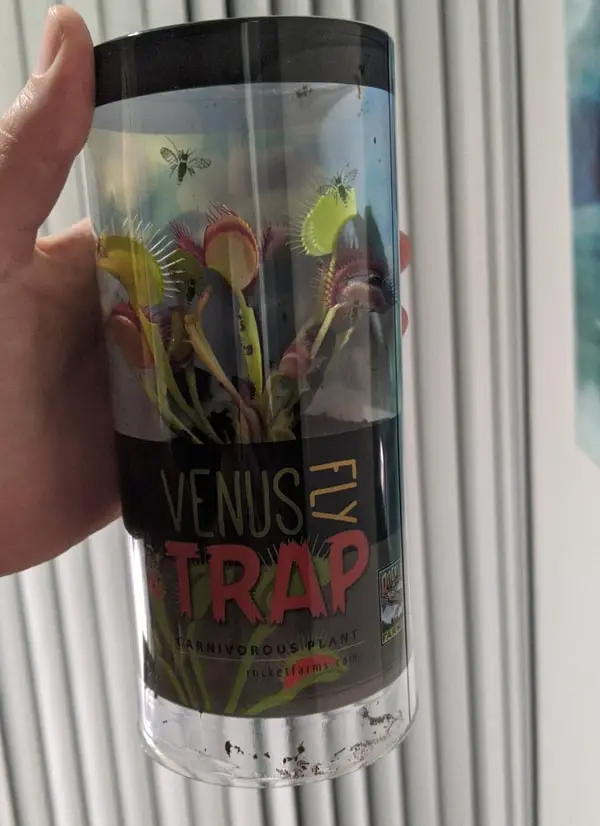When I first bought a Venus flytrap, it came in a closed and covered container. I was concerned about removing the plant from the dome and decreasing the humidity. Thankfully, after some research, I found out that those containers were not as critical as I thought.
Venus flytraps do not need to be covered; they thrive in open pots with plenty of access to light, water, and insects. Close containers block the light, prevent the plant from capturing bugs, and cause overheating issues in the summer.
Venus flytraps do not need to be covered, but they prefer humid environments. In this article, you will learn some easy to implement techniques to keep your Venus flytrap healthy.
Should Venus Flytrap Be Covered?
Large gardening stores and some nurseries sell Venus flytraps in domes. The containers provide some benefits for transporting the plants and preserving humidity and water within them. However, these containers are not necessary for growing Venus Flytraps.
The best place to grow Venus flytraps is outdoors, in open containers. They require high exposure to sunlight and water. Venus flytraps appreciate humid environments but can adapt to dry climates.
Covering Venus flytraps provides the benefit of extra humidity. However, Venus flytraps do not necessarily need high humidity; they can adapt.
I grow Venus flytraps in Arizona, which is very dry. Venus flytraps take a few weeks to adapt and eventually get used to the climate. I supplement my plants’ humidity using an electric humidifier to give them an extra boost. They do not really NEED the humidifier, but it helps with their development.
Covering a Venus flytrap causes several issues. For example, closed containers block the light, and Venus flytraps require a high amount of lighting. Also, covering Venus flytraps prevent them from capturing bugs. Venus flytraps do not need to consume insects to survive. However, adding bugs to their diet really help them accelerate growth.
Covered Venus flytraps can also easily overheat in the summer and freeze in the winter. Depending on the material of the container, some tend to conduct the exterior temperature. For example, glass domes left under direct sunlight can heat up and boil the plants inside.
How to Remove a Venus Flytrap From a Dome Container
I have seen many different companies sell Venus flytraps inside domes or terrariums. There is nothing wrong with buying one of these plants. As long as you verify, the Venus flytrap is healthy.
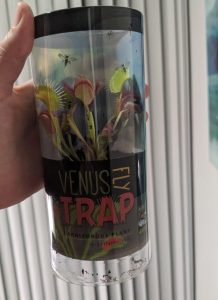
If you buy a plant inside a similar container to the one shown in the picture, make sure to adapt it to its new home slowly.
A plant inside a container has gotten used to a humid environment. Extracting these plants from their enclosure has to be done step by step. First, remove the lid or use a pair of scissors to make a few cuts in the container. Then, leave the plant alone for a couple of days. After that, you can remove it entirely from the containers.
Giving the Venus flytrap an extra couple of days to adapt to its new home is a good practice. Once the plant is free from the dome, make sure to follow the correct care instructions. I wrote this very detailed article on Venus flytrap care that can get you started!
Venus Flytrap Humidity and Watering Requirements
Venus flytraps are native to a very region. They grow in the states of North Carolina and South Carolina in the United States. They are typical exposed to humidity levels of over 50% year-round.
Venus flytraps are resilient plants that can adapt to a wide variety of humidity levels. If you live in a zone with 50% humidity or higher, then you are all set. There is no need to supplement the environment with a humidifier.
Zones with dry climates are a challenge for Venus flytraps; however, it is not impossible to grow Venus flytraps in arid climates. You can employ humidifiers and, most importantly, focus on watering your plant correctly.
When employing humidifiers, use them consistently. Venus flytraps take time to adapt to different climates. They prefer a consistent humidity level rather than sporadic hikes in humidity.
Venus Flytrap Watering Instructions
The most important care consideration for Venus flytraps in terms of humidity is the watering.
Venus flytraps need to be watered often. Their soil needs to be humid at all times until it is less humid. Then, it needs to be watered again. The soil should be moist at all times but not soggy.
Venus flytraps also need a very particular type of water. They are unable to process minerals and nutrients present in tap water or bottled water. For that reason, they can only be watered with pure water sources.
Only employ mineral-free water such as distilled water, reverse osmosis water or rain water for Venus flytraps. Water with minerals will cause mineral burns and eventually kill the plant.
Venus flytraps thrive in humid mediums. However, the soil should never be flooded. After watering, the soil of a Venus flytrap needs to be humid but not soaking wet. A good rule of thumb is to check the soil after watering. Use your fingers to press the soil. You should feel the humid ground but not get wet.
A common technique to water Venus flytraps is the water tray strategy. With this technique, the owner waters their plant from the bottom using a water tray. The process is straightforward:
- Place the plant pot in a tray. The tray needs to be at least 2 inches in depth.
- Then, employ mineral-free, nutrient-free water to fill the tray up to one inch in depth.
- Wait until the water has just dried up to water again.
The water tray method prevents overwatering a Venus flytrap. Also, it ensures the watering level is appropriate to keep the soil moist at all times. There is no need to water the plant from the top or mist it if employing this method.
Also, the tray holding the water increase the humidity level in the environment close to the plant. The change is minimal, but it is a plus.
I always employ the water tray method, which has helped my plants (and I) tremendously. Venus flytraps can consume large amounts of water, especially during the hot summer. A water reserve in the tray eases the process of watering and prevents the soil from drying up.
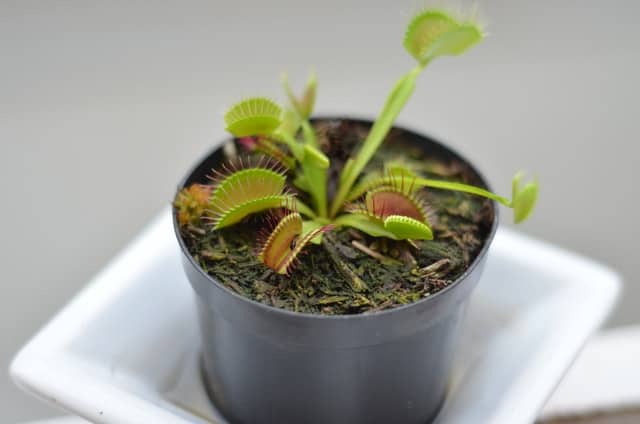
Are Terrariums Suitable for Venus Flytraps?
Growing Venus flytraps in a terrarium is a common trend nowadays. But, their implementation should be done carefully.
Venus flytraps prefer open containers rather than closed terrariums. It is possible to grow Venus flytraps in a terrarium in the short term, but it is not a suitable long-term practice. Also, Some terrariums are better suited than others for Venus flytraps.
Closed containers can harm Venus flytraps as they block light and prevent bugs from entering. Also, Venus flytrap need exposure to cold weather in the winter to undergo dormancy. When plants live in a closed terrarium, they can’t be exposed to near-freezing temperatures. Also, direct sunlight is not an option when growing Venus flytraps in a closed terrarium. The direct light can heat up the terrarium and kill the plants.
The best terrariums for Venus flytraps are greenhouse type terrariums. These terrariums are large structures that can open and closed without issues. Also, each plant in the terrarium has its own pot. Then, Venus flytraps can be removed from the terrarium in the winter and be placed outside for dormancy.
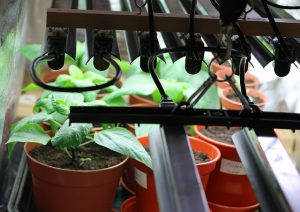
Depending on the size of the terrarium, it is possible to install artificial lighting inside the structure. The picture greenhouse terrarium picture shows an example of this practice. Artificial light can be equally effective at fulfilling your plant’s growing requirements.
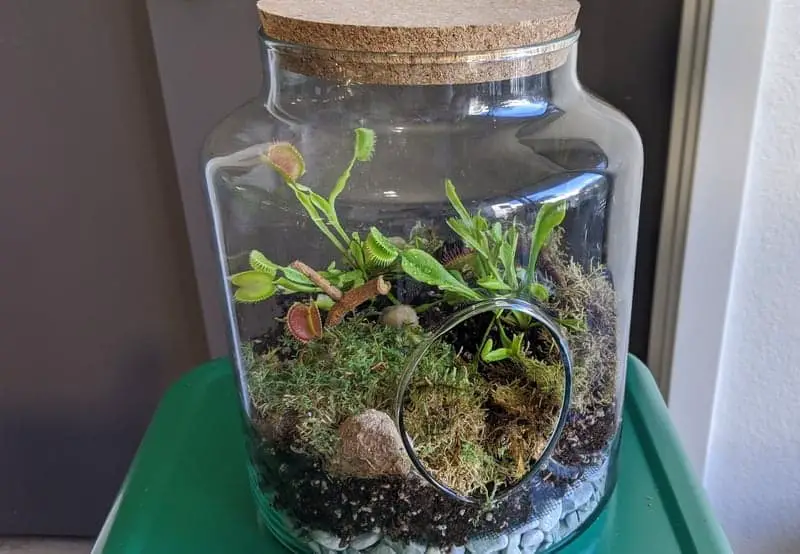
This picture shows a Venus fly trap terrarium I built. It is not the optimal setup for a Venus fly trap, but it was a very fun project. For several months, the plants have continued to live healthily in this semi-open terrarium. The opening in the glass container allows me to feed the plant. Also, I use artificial LED grow lights and shine the light through the opening.


